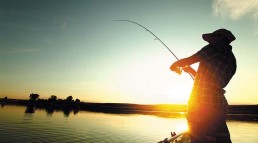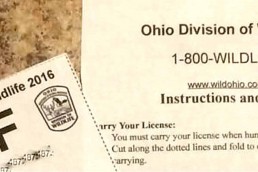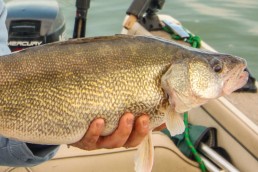Working on My Journeyman’s License
SHARE THIS POST
Though this past fall was another bountiful hunting season, the late-winter lull hit me hard this year. Earlier this week, I found myself chomping at the bit to get on the water. The smell of spring was carried in with a warm, south wind—a wind that I’m sure re-ignited the fire in most open-water anglers. Thankfully, the wonderful weather coincided with a day off for me and my beautiful wife. We took advantage of the opportunity and spent the afternoon walleye fishing on Pool 4 of the Mississippi River with our two dogs.
Despite living just a short 30-minute drive from the popular winter and spring walleye destination, I am still cutting my teeth on the intricacies that accompany fishing walleye just upstream of Red Wing. Skills like “jig-dragging” and properly fishing current seams are abilities that some fishermen spend their whole lives perfecting. Considering, that I’m still a self-proclaimed “apprentice river rat,” I’ll cut myself some slack on the empty livewell that followed us home on Tuesday.
Those of you who have made the annual mecca to Pool 4 during spring know how congested the water can get just below the dam. You’re certain to see everything from the freshly decaled Rangers ornamented in all of the sport’s biggest sponsors, to the 12-foot jon boat that nearly capsizes when it encounters any wake. The river however, has an unrelenting tendency to expose one major weakness that even the most expensive rig can’t necessarily compensate for—the ability to control your boat.
Are you enjoying this post?
You can be among the first to get the latest info on where to go, what to use and how to use it!
At the start of my river rat apprenticeship, I focused on all of the wrong things. Things like jig color, rod type, and line type are all important aspects to catching these fish and certainly deserve their own time for deliberation. However, I’ve recently realized that what sets an average river fisherman apart from good river fisherman isn’t if he/she is using a G. Loomis or St. Croix rod, or if he/she is using Northland Jigs or B-Fish-N jigs. The real difference maker is the ability to efficiently control your boat on areas that should be holding fish. The concept sounds simple enough. But to an apprentice like me, this can be a very difficult task when dealing with current, wind, and a legion of boats in pursuit of the same quarry as you.
So, here are a few quick tips to cut the learning curve for fellow apprentice river rats, or even anglers that are entirely new to fishing the river and maybe too intimidated by the sometimes staggering number of boats, to give it a shot.
- Just go for it! Plain and simple, you won’t learn how to best control your boat until you are on the water and learning on the fly. At this time of year, river conditions can change seemingly in a blink of an eye. These changing conditions will allow you to experience different scenarios of wind and current. Not to mention, these dynamic conditions will undoubtedly force you to pay close attention and keep you on your toes.
- Watch the boats that are catching fish. Pay attention to their relative position compared to current flow and wind direction. Try to keep an eye on their boat speed in relation to others. Are they going into the current or with it? Are they on the current seam, in slack water, or in the main channel? Don’t be afraid to sit near the back of the crowd and simply observe. There are some darned good fishermen on the river to take notes on.
- Know and use your electronics. This is a big one. Personally, I feel as though the biggest advance in fishing over the last couple of decades is the growth of systems like Minn Kota’s i-Pilot Link system. These boat control systems can truly transform normal guys like me into competent fishermen. Pay attention to your drift speed with the river current by using the GPS on your sonar/GPS unit. By using the electric motor, you can attain a speed that is capable of keeping your bait presentation near the bottom with minimal effort. Also, all of the newer sonar/GPS combos will track your recent paths. If one of your controlled drifts was more productive than another, simply re-do it.
- Backtroll. With the prevalence of the new electric trolling motors and how well they work, I see fewer and fewer “backtrollers.” However, us tiller guys always keep a small spot in our hearts for backtrolling. Sometimes I find just sitting down and putting the motor in reverse is a more efficient way of controlling my boat. Don’t be afraid to be the only guy on the river backtrolling. If it keeps you fishing and your jig near the bottom, then it looks to me like an efficient way to control your boat.
Certainly these few tips are quite broad and likely quite elementary for those journeyman river rats. However, for an apprentice like myself, looking upstream at 175 boats below the dam might be enough to make a guy turn around and re-trailer the boat. The fishery is good enough to make it worth putting the time in and learning the skills it takes to become a journeyman. Maybe these thoughts will give you enough confidence to squeeze your boat in and partake in the fun. The fish are there.
MWO
SHARE THIS POST
Did you enjoy this post?
You can be among the first to get the latest info on where to go, what to use and how to use it!
Lee Clancy
MidWest Outdoors works with more than 200 outdoor experts each year, who contribute articles based on their areas of expertise. MidWest Outdoors magazine offers more fishing and hunting articles than any other publication!



